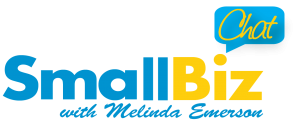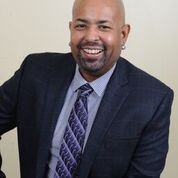 Every week as SmallBizLady, I conduct interviews with experts on my Twitter talk show #SmallBizChat. The show takes place every Wednesday on Twitter from 8-9pm ET. This is excerpted from my recent interview with @bskogrand. Brant Skogrand, APR, MBC, is the chief communications officer of Skogrand PR Solutions, a public relations, social media and search engine optimization firm based in Minneapolis. Skogrand is a Certified Search Engine Marketer, a Certified Master of Social Media and an accredited member of the Public Relations Society of America. He has earned several awards for his work and is the author of the book 19 Tips for Successful Public Relations. For more info, visit www.skograndpr.com.
Every week as SmallBizLady, I conduct interviews with experts on my Twitter talk show #SmallBizChat. The show takes place every Wednesday on Twitter from 8-9pm ET. This is excerpted from my recent interview with @bskogrand. Brant Skogrand, APR, MBC, is the chief communications officer of Skogrand PR Solutions, a public relations, social media and search engine optimization firm based in Minneapolis. Skogrand is a Certified Search Engine Marketer, a Certified Master of Social Media and an accredited member of the Public Relations Society of America. He has earned several awards for his work and is the author of the book 19 Tips for Successful Public Relations. For more info, visit www.skograndpr.com.
SmallBizLady: Many people have heard of search engine optimization (SEO). How would you define SEO?
Brant Skogrand: According to Search Engine College, where I became a Certified Search Engine Marketer, SEO is “the use of search engines to draw traffic to a website. It’s the technique of attaining a higher ranking in search engines and directories via alteration of website code and copy to make it more search engine compatible.”
SEO is divided into two categories: organic and paid. The Search Engine College definition mainly refers to organic SEO.
Paid (or pay-per-click) SEO also is important, because it can provide instantaneous visibility and be very useful for online marketing campaigns of a specific timeframe. Examples of pay-per-click SEO programs include Google AdWords and Bing Ads.
SmallBizLady: Why is SEO important?
Brant Skogrand: Think about your own web search habits. I know that even if I’m really searching for something, I don’t usually go past the fourth page of Google. I’m the exception, however. According to HubSpot, 75 percent of users never scroll past the first page of search results.
Getting onto the first or second page of search results for keywords that are relevant to your organization can make a big difference in visits to your website – and very likely in your business results.
There are approximately 200 ranking factors that go into Google’s algorithm, ranging from keywords to social signals to tags and beyond. Having an understanding of those ranking factors can help your website rise in the search results. It does take time as well as a fine balance between optimizing your website and over-optimizing your website, which the search engines frown upon.
SmallBizLady: Why are keywords important to SEO?
Brant Skogrand: Keyword research is probably the most crucial element to SEO. The search engines are looking to connect users with the most relevant sites. Keywords are more than just single words; they are the terms that potential site visitors would use in search engines to find your product or service.
Hopefully you already know who your target customer is. If not, start thinking about your target customer to move forward with your keyword research. Where do they live? What is their age range? What is your target customer’s gender?
Start writing down a “seed list” of keywords to choose from. For instance, a Minneapolis-based florist might start out with phrases that include the words “flowers,” “florists,” or “gifts.”
Those are pretty general terms though. Continuing on with the example of the Minneapolis-based florist, qualifying the terms will help you get closer to the phrases that visitors might actually use, such as “send flowers Minneapolis,” “florists Minneapolis,” “wedding bouquets Minneapolis,” “Valentine’s Day gifts Minneapolis,” etc.
This final list of keywords is important, because you will want to use them throughout your website: in the text, in headers, in the title of your website, and more. Most webpages can only be optimized for a maximum of two to three keywords or phrases. So, if you have a 10-page website to optimize, you’ll need approximately 30 keywords of phrases to target. You probably would want to come up with more words than that, though. It’s always good to have more keywords to choose from.
Some of the best resources that I have found to determine the actual traffic for various keywords include the Keyword Planner tool on the Google AdWords website, SEMrush and Raven Tools.
SmallBizLady: What role do tags have in SEO?
Brant Skogrand: The title tag in particular is very important. Search Engine College defines the title tag as “a descriptive name of a page that is shown by browsers as the page name in the browser window.”
After the overall content of a webpage, the title tag is considered the single most important on-page SEO element.
Search engines prefer when your website has a unique title for each page, and may even ignore pages that have the same titles.
Search results limit the number of characters that they show for page titles. The best practice is to keep page titles to a length between 10 and 70 characters.
Use your keywords in your title tag. Put the most important keywords first, as search engines read from left to right.
The meta description tag also is important, as search engines often display this short, helpful summary of your page’s content. Searchers also use the meta description tag to decide which result to click on. A general best practice is to keep the meta description tag to a minimum of 50 characters and a maximum of 156 characters.
SmallBizLady: How can photos be optimized for SEO?
Brant Skogrand: Since search engines are visually impaired, flashy webpages aren’t as useful as ones that have an appropriate level of text to help the search engines with appropriate context to understand the content and its quality.
Best practices recommend at least 250 words of text on each webpage.
I like to take advantage of any optimization possibility, however, and each photo has the opportunity for associated text. Both ALT text and title text for a photo provide search engines with useful information about the subject matter of an image. The search engines in turn use this information to determine the best image to return for a searcher’s query.
SmallBizLady: SEO is constantly changing. How can people keep up?
Brant Skogrand: Several websites are very useful that track search engine updates, including: Search Engine Journal, Search Engine Watch, Moz and Search Engine Land.
Matt Cutts, the head of Google’s Webspam team, also has a blog with very useful information.
Many search engine updates, such as Google’s recent announcement that websites that automatically encrypt their services will be boosted in Google’s ranking formula, are covered in the mainstream media.
SmallBizLady: What were the effects of the most recent Google updates?
Brant Skogrand: Google changes its search algorithm around 500 to 600 times each year. Most of the changes are minor, but sometimes there’s a major algorithmic update – such as Google Panda or Google Penguin.
Recent updates include Pigeon (updates to local search algorithms), Panda 4.0 (part of an update to prevent sites with poor quality content to get into the top search results), changes to Google Authorship, and Payday Loan (an anti-spam update).
SmallBizLady: How can SEO be measured?
Brant Skogrand: Hopefully it ties to business results.
While you can look at where your website ranks in the search results, there are more measures to look at by having Google Analytics installed on your website, which can track site usage and visitor behavior.
With Google Analytics, you can set a goal conversion – meaning that if people visit a certain page, request an appointment, buy an item, etc., you are meeting specific goals for your website.
Other measurements in Google Analytics range from bounce rate (the percentage of visitors who enter the site and “bounce” (leave the site) rather than continue viewing other pages within the same site) to the geographic location of site visitors to the most popular content and more.
SmallBizLady: What role does social media and public relations have in relation to SEO?
Brant Skogrand: Earlier this year, Google’s Matt Cutts said, “But as far as doing special specific work to sort of say ‘you have this many followers on Twitter or this many likes on Facebook,’ to the best of my knowledge we don’t currently have any signals like that in our web search ranking algorithms.”
There’s value in having an active presence on Twitter, Facebook and other social networks (like Google+), however, because it can be a way to drive traffic and visitors to your website.
Having a blog on your website also can be valuable as a way to demonstrate thought leadership. Search engines also reward sites that frequently refresh content, which generally can be accomplished by having a blog.
There’s also value in obtaining media coverage through public relations outreach. The resulting articles could drive traffic to your website and increase the popularity of your organization. In addition, media websites often link to the websites of companies that they cover, which can be a boost to your organization’s SEO efforts.
SmallBizLady: How can entrepreneurs learn more about SEO?
Brant Skogrand: I found the Search Engine College program very helpful. Their curriculum covers topics ranging from organic SEO to pay-per-click to copywriting and beyond. It’s on online program, and tutors grade your assignments.
Google also offers free online courses through Google Analytics Academy to help people improve their Analytics skills. There also are Google Partners certifications, including the AdWords certification, to demonstrate proficiency.
SmallBizLady: Why did you decide to write the 19 Tips for Successful Public Relations book?
Brant Skogrand: Many organizations struggle with how to successfully integrate public relations into their marketing mix.
Because of the numerous demands on entrepreneurs’ time and money, many small business owners neither are able to learn public relations on their own nor hire an outside public relations firm.
My goal with the book is to help entrepreneurs learn small business public relations through straightforward tips and by analysis of real-life examples – and then be able to apply public relations strategies and tactics to help achieve their business goals.
SmallBizLady: Are there any other tips for SEO that you can give to startups and developing businesses?
Brant Skogrand: As you probably have noticed, there are a lot of factors that go into SEO and it can be tough to keep up with the changes.
Even though you can do it on your own, the results generally are better when you hire an outside professional.
Be wary of people who guarantee results. Since we don’t run Google or Bing, we can’t guarantee that your website will rank at the top of the search results for specific terms. By using our knowledge and experience, however, your site should see optimization improvements.
“Key With Keywords Text” courtesy of Stuart Miles / www.freedigitalphotos.net
If you found this interview helpful, join us on Wednesdays 8-9 pm ET; follow @SmallBizChat on Twitter. Here’s how to participate in #SmallBizChat: http://bit.ly/1hZeIlz
For more tips on how start or grow your small business subscribe to Melinda Emerson’s blog http://www.succeedasyourownboss.com.
The post Understanding the Basics of Search Engine Optimization appeared first on SucceedAsYourOwnBoss.com.
 Every week as SmallBizLady, I conduct interviews with experts on my Twitter talk show #SmallBizChat. The show takes place every Wednesday on Twitter from 8-9pm ET. This is excerpted from my recent interview with
Every week as SmallBizLady, I conduct interviews with experts on my Twitter talk show #SmallBizChat. The show takes place every Wednesday on Twitter from 8-9pm ET. This is excerpted from my recent interview with  Every week as SmallBizLady, I conduct interviews with experts on my Twitter talk show #SmallBizChat. The show takes place every Wednesday on Twitter from 8-9pm ET. This is excerpted from my recent interview with
Every week as SmallBizLady, I conduct interviews with experts on my Twitter talk show #SmallBizChat. The show takes place every Wednesday on Twitter from 8-9pm ET. This is excerpted from my recent interview with  Every week as SmallBizLady, I conduct interviews with experts on my Twitter talk show #SmallBizChat. The show takes place every Wednesday on Twitter from 8-9pm ET. This is excerpted from my recent interview with
Every week as SmallBizLady, I conduct interviews with experts on my Twitter talk show #SmallBizChat. The show takes place every Wednesday on Twitter from 8-9pm ET. This is excerpted from my recent interview with  #SmallBizChat is a weekly conversation where small business owners can get answers to their questions. The focus of #SmallBizChat is to end small business failure by helping participants succeed as your own boss.
#SmallBizChat is a weekly conversation where small business owners can get answers to their questions. The focus of #SmallBizChat is to end small business failure by helping participants succeed as your own boss.  October 1: How to Build Wealth Through Your Business,
October 1: How to Build Wealth Through Your Business,  October 8: When She Makes More: 10 Rules for Breadwinning Women,
October 8: When She Makes More: 10 Rules for Breadwinning Women,  October 15: How to Master, Manage and Communicate Your Message,
October 15: How to Master, Manage and Communicate Your Message,  October 22: How to Think About Cyber Security in Your Small Business (Sponsored by Staples and Symantec),
October 22: How to Think About Cyber Security in Your Small Business (Sponsored by Staples and Symantec),  October 29: How to REALLY Make Sales!
October 29: How to REALLY Make Sales!  Every week as SmallBizLady, I conduct interviews with experts on my Twitter talk show #SmallBizChat. The show takes place every Wednesday on Twitter from 8-9pm ET. This is excerpted from my recent interview with
Every week as SmallBizLady, I conduct interviews with experts on my Twitter talk show #SmallBizChat. The show takes place every Wednesday on Twitter from 8-9pm ET. This is excerpted from my recent interview with  Every week as SmallBizLady, I conduct interviews with experts on my Twitter talk show #SmallBizChat. The show takes place every Wednesday on Twitter from 8-9pm ET. This is excerpted from my recent interview with
Every week as SmallBizLady, I conduct interviews with experts on my Twitter talk show #SmallBizChat. The show takes place every Wednesday on Twitter from 8-9pm ET. This is excerpted from my recent interview with  Every week as
Every week as  Every week as
Every week as  Every week as
Every week as  Every week as
Every week as  Every week as
Every week as  Every week as
Every week as 
 Every week as
Every week as  Melinda Emerson, Twitter’s
Melinda Emerson, Twitter’s  Every week as SmallBizLady, I conduct interviews with experts on my Twitter talk show #SmallBizChat. The show takes place every Wednesday on Twitter from 8-9 pm ET. This is excerpted from my recent interview with John Lawson, CEO of ColderICE Media (@ColderICE).
Every week as SmallBizLady, I conduct interviews with experts on my Twitter talk show #SmallBizChat. The show takes place every Wednesday on Twitter from 8-9 pm ET. This is excerpted from my recent interview with John Lawson, CEO of ColderICE Media (@ColderICE).  Every week as SmallBizLady, I conduct interviews with experts on my Twitter talk show #SmallBizChat. The show takes place every Wednesday on Twitter from 8-9 pm ET. This is excerpted from my recent interview with Jay Bean @jayrbean and @freshlime_inc. Jay is founder and CEO of FreshLime. Heis a focused and innovative entrepreneur with over a decade of online marketing and digital experience. Jay has a proven record of growing digital media technology and online advertising-based businesses with his singular vision. For more information about Jay, visit
Every week as SmallBizLady, I conduct interviews with experts on my Twitter talk show #SmallBizChat. The show takes place every Wednesday on Twitter from 8-9 pm ET. This is excerpted from my recent interview with Jay Bean @jayrbean and @freshlime_inc. Jay is founder and CEO of FreshLime. Heis a focused and innovative entrepreneur with over a decade of online marketing and digital experience. Jay has a proven record of growing digital media technology and online advertising-based businesses with his singular vision. For more information about Jay, visit  Every week as SmallBizLady, I conduct interviews with experts on my Twitter talk show #SmallBizChat. The show takes place every Wednesday on Twitter from 8-9 pm ET. This is excerpted from my recent interview with Christine Kloser,
Every week as SmallBizLady, I conduct interviews with experts on my Twitter talk show #SmallBizChat. The show takes place every Wednesday on Twitter from 8-9 pm ET. This is excerpted from my recent interview with Christine Kloser, 







